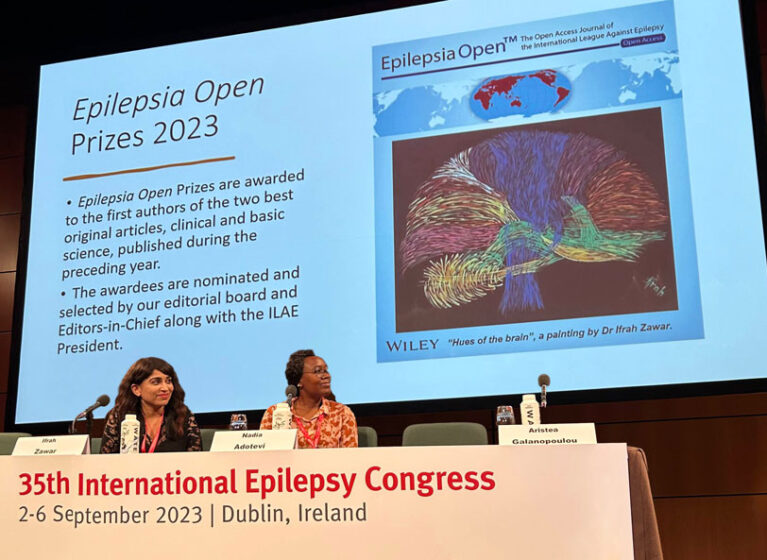
Nonconvulsive seizures are common among critically ill patients. Monitoring them with continuous electroencephalogram (cEEG) can make a significant difference in patient morbidity and mortality outcomes. But how long to monitor is not clear.
Award-winning research at UVA Health brings us closer to this answer. By uncovering key risk factors, this research shows that optimal cEEG monitoring may go well beyond the standard 24 hours for certain patients.
Led by neurologist Ifrah Zawar, MD, this research has the potential to impact a large patient population, as up to 20% of critically ill patients undergoing cEEG monitoring have subclinical seizures. Zawar received the prestigious Epilepsia Open Prize for her work, an award that is given to the single best clinical research paper from all articles published in this official International League Against Epilepsy (ILAE) journal in one year.
“We know from previous studies that a majority of epileptic seizures are detected within 24 hours, but most of these studies look at optimal EEG time in a highly selective population,” Zawar says. “Our goal was to determine risk factors that might predict delayed seizure detection, develop risk stratification scores, and find the optimal time for cEEG monitoring based on these risks.”
A New Approach to cEEG
Zawar began her impactful research during her residency at Cleveland Clinic. She collected data from 2,402 adult patients who underwent cEEG over a one-year period and analyzed the data to determine the average time to detect subclinical seizures. Of these patients, 316 had at least one subclinical or nonconvulsive seizure.
The study found that seizure detection increased linearly for up to 36 hours of monitoring, and the odds of seizure detection increased by 46% for every additional day of monitoring. Given this linear trend, Zawar hypothesized that standard monitoring of 36 hours may be more effective than 24 hours, particularly for high-risk patients.
Broadly, awake patients with limited risk factors benefited from 24 hours of cEEG. However, Zawar found several risk factors for delayed seizure detection. These include:
- Acute brain insults
- Altered mental status
- Anti-seizure medication use at the time of cEEG initiation
- Brain hemorrhage
- Lateralized or generalized periodic discharges
- Lethargy
- Stupor and coma
For some of these high-risk patients, even longer cEEG (48 hours or greater) may need to be considered.
“These findings can have a significant impact for critical patients undergoing cEEG,” says Zawar. “With the development of standard continuous monitoring, we can improve seizure detection and patient care for critically ill and high-risk patients, such as by delivering medication that improves outcomes promptly.”
Shifting Treatment Guidelines
Based on their findings, Zawar and her team proposed adjusted guidelines for repeat cEEG monitoring for certain high-risk patients based on their clinical risk factors. The goal of these guidelines is to reduce epilepsy-related morbidity and mortality. In addition, these findings have the potential to change clinical practice and lead to better resource allocation by increasing the efficiency of cEEG monitoring. Neurologists, epileptologists, ICU physicians, and other providers can all benefit from these findings.
“When making treatment decisions, clinicians can now look at a variety of factors for each patient,” says Zawar. “From clinical features to the medications they are on, they can have a clearer understanding of the need for monitoring for individual patients.”
Zawar’s next goal is to build a predictive model incorporating various clinical features, EEG features, indications for cEEG, and causes for presentation, which can help physicians determine the optimal timing of monitoring in critically ill patients.
“These findings will help determine which high-risk patients will benefit the most from prolonged monitoring,” says Zawar. “We hope that this predictive model can significantly improve clinical care for these patients in the future.”
Leading the Way in Epilepsy Research
Zawar is already driving her epilepsy research forward, having earned three foundational and federal research grants in just two years since joining UVA Health under the mentorship of Jaideep Kapur, MD, at UVA Health. Her new initiatives include epilepsy research in older adults and people with dementia, including identifying risk factors that predict seizures in these patients.
Additionally, she has received multiple honors and awards for her research since joining UVA Health. Recently, her research was recognized with the American Neurological Association Annual Meeting Research Travel Award in October 2022 and the American Epilepsy Society Grass Foundation Young Investigator Award in December 2022. Her significant research findings were also covered by 200+ media outlets all over the country, including U.S. News and World Report in December 2022. Internationally recognized for her research endeavors, she is also at the forefront of an international initiative composed of 8 leaders in the field, with the goal of formulating guidelines for an under-recognized epilepsy syndrome.
“The epilepsy division at UVA Health has some of the most renowned and accomplished clinician scientists,” says Zawar. “The collegial work environment and the mentorship and research opportunities at UVA Health are some of the reasons why I chose to come to Charlottesville.”
UVA Health is a leader in epilepsy research and Zawar is not alone in her recognition. Epilepsia Open grants just two research prizes every year from all over the world, one in clinical research and one in basic science research. The other 2023 awardee is also a UVA Health researcher, Nadia Adotevi, PhD, who was recognized for her basic science research on temporal lobe epilepsy with Kapur.
“I am eternally grateful and truly in debt to my research mentors, colleagues, and my department chair, who have been immensely helpful in shaping my research career and continue to help me every step of the way,” says Zawar. “This award is such a great honor for me and my lab and an acknowledgment that hard work always pays off. This prize has further strengthened my drive to continue meaningful clinical research in epilepsy.”